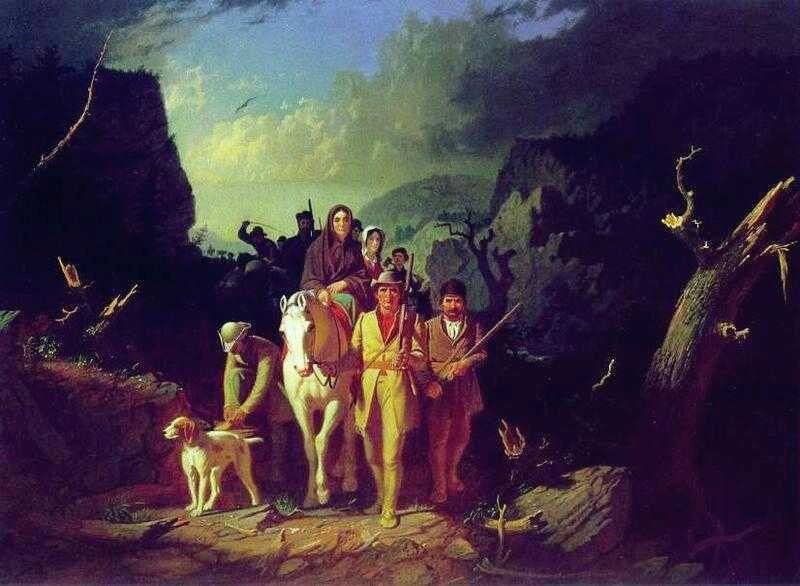
Daniel Boone (United States, 1734-1820)

Figure 1.-- Daniel Boone led the first small party through the Cumberland Gap into Kentucky (1769) at at a time that the British Government was trying to restrict the colonists to the Eastern Seabord. This is widely seen as the beginning of the American western movement. He returned with a larger party, including Rebecca. This was importalized by George Caleb Bingham's famed painting. It was painted years afterwards, 1851-52. We have very few images of frontier children. This image is useful because the children would have dressed much like their parents. We do have some 18th century paintings of children, but they are all of affluent city children and not backwoods children. This was a historical painting, but Bingham produced many important cointemprage images of the Western frontier before the Civil War.
|
|
Daniel Boone is such a remarkable figure in American history that he often is viewed as more of a fictional folk hero than a historical figure. In fact his exploits are even more remarkable than fictional accounts. He was born in Pennsylvania to a family of English Quakers (1734). We know very little about his early childhood. His father moved their large family to Virginian when Daniel was a teenager and then on to the Yadkin Valley of North Carolina. Still a teen ager, Daniel developed a reputation as a skilled trapper and hunter and particularly as an expert markesman. He married at age 19 to Rebecca Bryan who was 15. Rebecca is surely one of the most notable backwoods American women. [Morgan] The marriage resulted in a deep and lasting attachment and a number of children. Boone led the first small party through the Cumberland Gap into Kentucky (1769) at at a time that the British Government was trying to restrict the colonists to the Eastern Seabord. This is widely seen as the beginning of the American western movement. He returned with a larger party, including Rebecca. This was importalized by George Caleb Bingham's famed painting. He led subsequently led many other parties. Boone is often associated with the Scotts-Irish because so many of the families he led into Kentucky were of Scotts Irish ancestry. He founded Boonesborough and helped lead the resistance to Native Americans backed by the British. Unlike many clonists, he admired the Native Americans. Despite the carnage durung the Revolutionary War, he admitted to only killing one Native American. He was captured by the Shawnee (1778), but rather than being killed by them, he had an amazing rapport and was adopted by them. They named him "Big Turtle". Boone spent 4 monthswuth them before escaping back to Boonesville. One biographer writes, "Of famous white Americans, only Sam Houston appears to have had a comparable knack for fitting in with Native peoples." [Morgan] A school teacher published an account of the frontier that turned Boone into an American legend. [Filson] Afterthe Revolution Boone's star faded because of a series of failed land deals. He finally moved to Missori, complining that Kentucky was too crowded. He lived to old age there, regailing visitors with accounts of his exploits in Kentucky. He finally passed away in Missouri (1820). Boone is undoubtedly a major figure in the building of America. He was, however, a tragic figure because it was the wild America and the untrameled frontier he loved and not the settled territory. [Morgan] This in part explains his connection with Native Americans. Yet his life was spent in making settkement and the destruction of the frontier possible.
Filson, John. The Discovery, Settlement, and Present State of Kentucke (1784).
Lofaro, A. Daniel Boone: An American Life (2003).
Morgan, Robert. Boone: A Biography (Algonquin, 2007).
HBC

Return to related pages:
[Ringlet curls]
[Bangs]
[Main Fauntleroy page]
[Vivian Burnett]
[Kilts]
[Dresses]
[Long stockings]
[Lace collar]
[The 1870s]
[Strap shoes]
[Eton suits]
[Sailor hats]
Navigate the Boys' Historical Clothing Web Site:
[Return to the Main Bio A-B page]
[Return to the Main Revolutionary War biography page]
[Return to the Main Revolutionary War campaigns]
[Introduction]
[Activities]
[Biographies]
[Chronology]
[Cloth and textiles]
[Clothing styles]
[Countries]
[Topics]
[Bibliographies]
[Contributions]
[FAQs]
[Glossaries]
[Images]
[Links]
[Registration]
[Tools]
[Boys' Clothing Home]
Created: 6:35 AM 11/12/2007
Last updated: 6:35 AM 11/12/2007



